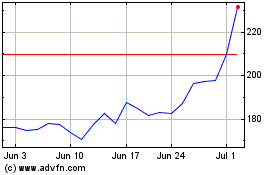Tesla Motors Inc. is changing the way its Autopilot system works
following the fatal crash in May of a car that was driving under
semi-autonomous control.
The revision, which Tesla Chief Executive Elon Musk outlined
Sunday, will depend more on radar signals to help guide Tesla
vehicles along roadways, and adds safeguards to keep drivers
engaged at high speed.
The software updates will be rolled out within the next two
weeks and delivered to vehicles over the air, he said. They will
affect Tesla vehicles built since October 2014, before which the
hardware used by Autopilot wasn't included.
Autopilot, which uses cameras, radar and sensors to steer
vehicles and adjust their speed, has come under scrutiny since the
Florida crash that killed Tesla driver Joshua Brown in May, the
first known death of a driver using the system.
The car in the May 7 incident failed to brake automatically
because the system didn't distinguish a truck's white trailer from
the bright sky, Tesla has said.
The National Highway Traffic Safety Administration is
investigating the crash, focusing on the emergency-braking and
forward-collision warnings.
The changes announced on Sunday might have prevented the
accident, Mr. Musk said.
Mr. Musk told reporters on a conference call that the changes
will make the system even safer. "This is not going from bad to
good. It's going from good to, I think, great."
"Ultimately, this will probably be a threefold improvement in
safety" compared with the current version, Mr. Musk told reporters
on a conference call. "This is not going from bad to good. It's
going from good to, I think, great."
Autopilot is regarded as a major step toward self-driving cars,
though Tesla warns users that the technology doesn't make Tesla
vehicles autonomous and that drivers must remain ready to take
control.
Despite those warnings, some experts have questioned whether the
technology might lead users to rely too much on the vehicle's
driving capabilities.
Consumer Reports, for example, wrote that Autopilot was " too
much autonomy too soon."
As part of the changes to Autopilot, the system will disengage
if drivers ignore three warnings within the span of an hour to keep
their hands on the wheel. To reactivate the system, the vehicle
would have to be stopped and restarted.
Mr. Musk has vigorously defended the Autopilot technology,
saying it improves safety. When activating the system, drivers must
acknowledge by clicking on a screen that they are responsible for
the vehicle.
Radar, which was added to Tesla vehicles in October 2014, had
been a supplement to the onboard camera and image-processing
technology, the company said Sunday.
Using radar, which detects objects by sending out pulses of
electromagnetic waves to detect objects, to guide vehicles is
complicated because the waves interact differently than light waves
with objects in the roadway.
"The big problem in using radar to stop the car is avoiding
false alarms," Mr. Musk wrote in a blog post on the company's
website. "Slamming on the brakes is critical if you are about to
hit something large and solid, but not if you are merely about to
run over a soda can."
Part of the solution, according to Mr. Musk, is to take
advantage of Tesla vehicles' ability to communicate with one
another and collaborate on their understanding of road conditions.
"The net effect of this…is that the car should almost always hit
the brakes correctly even if a UFO were to land on the freeway in
zero visibility conditions," Mr. Musk wrote.
Tesla's decision to update its radar software intensifies Mr.
Musk's bet that radar is an effective technology to help cars
navigate the world. Alphabet Inc.'s Google unit and others racing
toward fully self-driving cars are counting on a technology known
as lidar, which is similar to radar but uses lasers.
Mr. Musk reiterated on Sunday that he doesn't anticipate using
lidar because it doesn't have the same capabilities as radar.
Asked whether the improvements would have prevented the fatal
Florida crash, Mr. Musk said he believed so because the radar would
have detected the trailer. "It would see a larger metal object
across the road," he said.
Some Tesla drivers have admitted that Autopilot's success may
have lulled them into a false sense of security. "I look down at my
phone a little more than I used to," Jason Hughes, an Autopilot
user from Hickory, N.C., told The Wall Street Journal in July.
"People are overly confident in it, in my opinion. They think it
can do magical things, but it can't go beyond what its sensors tell
it."
Mr. Musk appeared to acknowledge this on Sunday, saying that
Autopilot accidents are far more likely among expert users then
novices. The current system alerts drivers when their hands have
been off the wheel too long depending upon driving conditions, and
it slows the vehicles if they don't respond. Some users ignored 10
warnings to keep their hands on the wheel in an hour, he said.
"They get very comfortable with it and repeatedly ignore the car's
warnings," he said. "We really want to avoid that situation.".
As he responds to Tesla safety concerns, Mr. Musk also faces
controversy for proposing in June to combine Tesla and SolarCity
Corp., where he is chairman, and questions why one of his Space
Exploration Technologies Corp. rockets exploded during routine
fueling on Sept. 1.
Write to Tim Higgins at Tim.Higgins@dowjones.com
(END) Dow Jones Newswires
September 11, 2016 21:15 ET (01:15 GMT)
Copyright (c) 2016 Dow Jones & Company, Inc.
Tesla (NASDAQ:TSLA)
Historical Stock Chart
From Mar 2024 to Apr 2024

Tesla (NASDAQ:TSLA)
Historical Stock Chart
From Apr 2023 to Apr 2024
